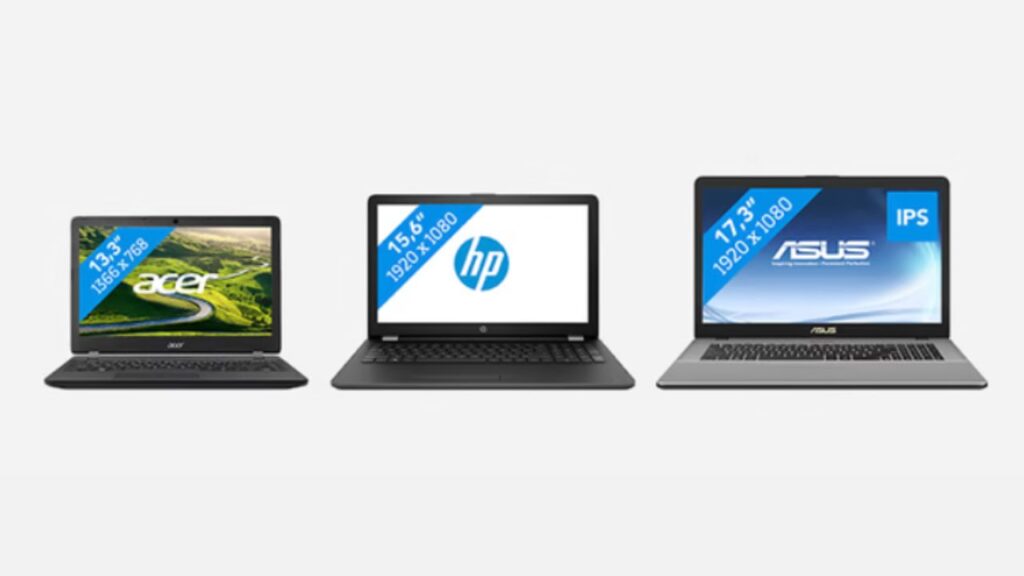When searching for a laptop, it’s crucial to factor in the type of screen it incorporates.
Screens vary significantly in quality, and a subpar display can be a deal-breaker, especially considering the extended periods you’ll spend gazing at it.
Deciphering the myriad acronyms, ratings, and seemingly arbitrary numbers associated with screens can be perplexing.
If terms like IPS and TN displays or the significance of “nits” leave you puzzled, fear not – you’ve landed in the right place.
This article aims to demystify the complexities and highlight key considerations when selecting the screen for your laptop.
What is the standard laptop screen size?
Since the cutoff in January 2024, there has yet to be a single standard laptop screen size, as laptops come in various sizes to cater to different user preferences and needs. However, some sizes are more commonly found in the market.
- 13 to 14 inches: These laptops strike a balance between portability and usability. They are often preferred by those who need a laptop for both work and travel.
- 15-inches: This is a popular size for mainstream laptops, offering a good compromise between screen real estate and portability. Many gaming laptops and high-performance machines fall into this size category.
- 17-inches and above: Laptops with screens larger than 17 inches are often considered desktop replacements. They are suitable for users who prioritize a larger display for gaming, content creation, or entertainment and are less concerned about portability.
Choosing The Best Laptop Screen Size?
Resolution:
The resolution of a laptop screen determines the clarity and sharpness of the images displayed.
Higher resolution screens, such as Full HD (1920 x 1080) or 4K (3840 x 2160), provide more detail and are ideal for creative professionals and multimedia enthusiasts.
A standard HD (1366 x 768) resolution may suffice for everyday tasks. Consider your usage patterns before deciding on the resolution that best suits you.
Display Screen Size:
Laptop screens come in various sizes, ranging from compact 11-inch displays to expansive 17-inch behemoths.
The ideal size depends on your preferences and how you plan to use the laptop.
Smaller screens are more portable and suitable for on-the-go users, while larger screens provide a more immersive experience for gaming and multimedia consumption.
Panel Type:
The panel type significantly affects the display quality. The most common types are IPS (In-Plane Switching), TN (Twisted Nematic), and OLED.
IPS panels offer wide viewing angles and accurate color reproduction, making them suitable for graphic design and content creation.
TN panels, on the other hand, are faster in terms of response time, making them preferable for gaming.
OLED panels deliver vibrant colors and deep blacks but are often found in higher-end laptops.
Brightness and Contrast:
A bright and well-contrasted display ensures a clear and readable screen in various lighting conditions.
Look for laptops with higher nits for brightness and a higher contrast ratio for vivid and lifelike visuals. This is particularly crucial if you work outdoors or in brightly lit environments.
Refresh Rate:
For gamers and video enthusiasts, the refresh rate of the laptop screen is a critical consideration.
A higher refresh rate, such as 120Hz or 144Hz, provides smoother motion and reduces motion blur. However, for general use, a standard 60Hz refresh rate is sufficient.
Color Accuracy:
If your work involves tasks like photo or video editing, color accuracy is paramount.
Look for laptops with a wide color gamut, measured in percentages of sRGB or Adobe RGB. A higher percentage indicates a more accurate representation of colors.
Touchscreen Capability:
Some laptops come with touchscreen displays, offering a more interactive and intuitive user experience.
If you find touch input beneficial for your workflow or prefer its versatility, consider a laptop with this feature.
Durability and Coating:
Consider the durability of the screen, especially if you travel frequently. A scratch-resistant or Gorilla Glass-coated display can protect your laptop from everyday wear and tear.
Conclusion:
Choosing the best laptop screen and live streaming involves considering a combination of factors tailored to your specific needs and preferences.
Whether you prioritize resolution for crisp visuals, color accuracy for creative work, or a high refresh rate for gaming, finding the right balance will enhance your overall computing experience.
Take the time to assess your usage patterns. Armed with this knowledge, make an informed decision to ensure that your laptop screen meets your expectations and provides a delightful visual experience. Comment here.

